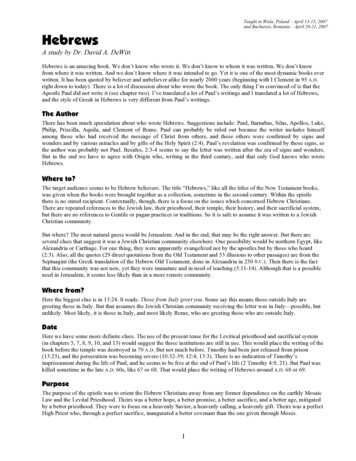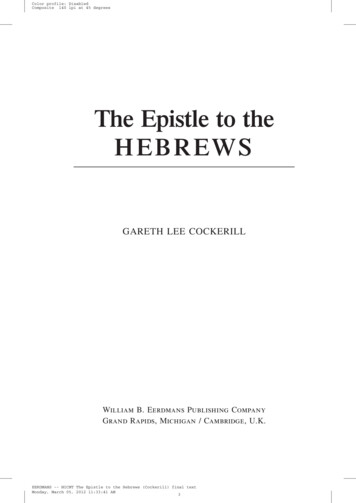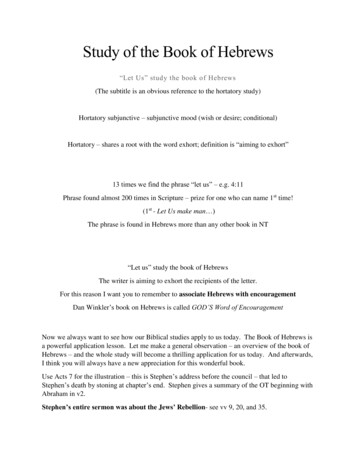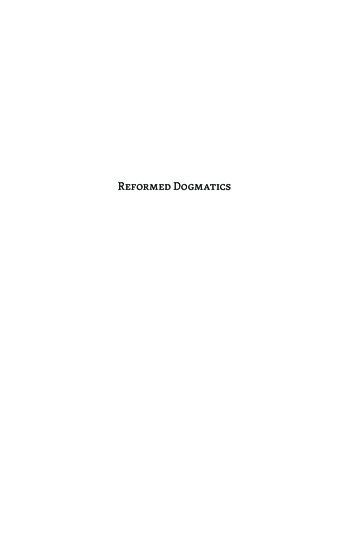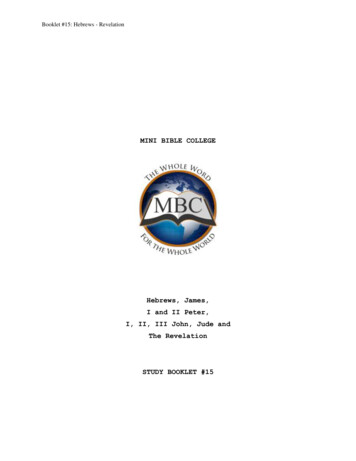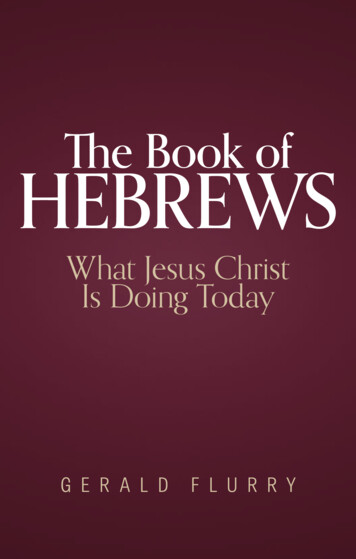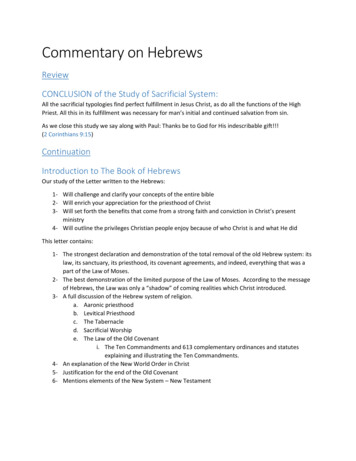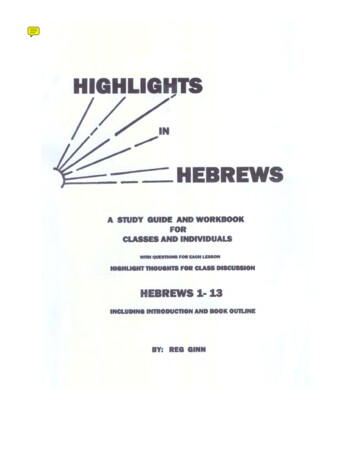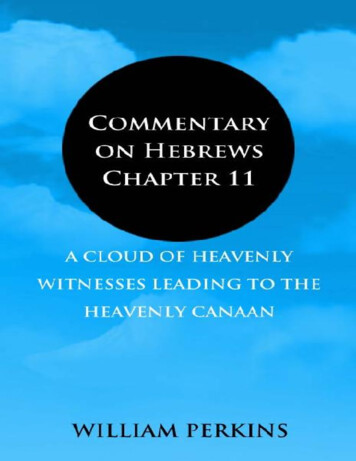
Transcription
An Exposition ofHebrewsbyArthur W. Pink
Copyright (Public d on the Web)
1AN EXPOSITION OF HEBREWSBy AW PinkCHAPTER ONEIntroductionBefore taking up the study of this important Epistle let writer and reader humbly bowbefore its Divine Inspirer, and earnestly seek from Him that preparation of heart which isneeded to bring us into fellowship with that One whose person, offices, and glories arehere so sublimely displayed. Let us personally and definitely seek the help of that blessedSpirit who has been given to the saints of God for the purpose of guiding them into alltruth, and taking of the things of Christ to show unto them. In Luke 24:45 we learn thatChrist opened the understanding of the disciples "that they might understand theScriptures." May He graciously do so with us, then the entrance of His words will "givelight" (Ps. 119:130), and in His light we shall "see light."In this opening article we shall confine ourselves to things of an introductory character,things which it is necessary to weigh ere we take up the details of the Epistle. We shallconsider its addressees, its purpose, its theme, its divisions, its characteristics, its value,and its writer. Before doing so, let us say that we expect to quote freely from otherexpositors, and where possible name them. In some cases we shall not be able to do soowing to the fact that extensive and long-distance traveling has obliged the writer tobreak up five libraries during the last twenty years. During those years he has read (andowned most of them) between thirty and forty commentaries on Hebrews, from which hehas made notes in his Bible and taken helpful extracts for his own use when lecturing onthis Epistle. As most of these commentaries have been disposed of, we can now do nomore than make a general acknowledgement of help received from those written by Drs.John Owen, John Gill, Moses Stewart, Andrew Bonar, Griffith-Thomas, and Messrs.Pridham, Ridout, and Tucker. Let us now consider:—1. Its Addressees.In our English Bibles we find the words "The Epistle of Paul the Apostle to the Hebrews"as the address. Perhaps some of our readers are not aware that the titles found at the headof the different books of the Bible are not Divinely inspired, and therefore are notaccounted canonical as are the contents. No doubt these titles were originated by the earlyscribes, when making copies of the original manuscripts—manuscripts, all traces ofwhich have long since disappeared. In some instances these titles are unsatisfactory; in afew, grossly erroneous. As an example of the latter, we may refer to the final book ofScripture. Here the title is "The Revelation of St. John the Divine," whereas the openingsentence of the book itself designates it "The Revelation of Jesus Christ!"
2While treating in general with the titles of the books of Scripture, we may note that inalmost all of the Epistles there is a Divinely-named addressee in the opening verses. Butwe may add, the contents of each Epistle are not to be restricted to those immediately andlocally addressed. It is important that the young Christian should grasp this firmly, so thathe may be fortified against ultra-dispensational teaching. There are some, claiming tohave great light, who would rob the saints today of the Epistle of James because it isaddressed to "the Twelve Tribes which are scattered abroad." With equal propriety theymight take from us the Epistles to the Philippians and Colossians because they wereaddressed only to the saints in those cities! The truth is that what Christ said to theapostles in Mark 13:37—"What I say unto you, I say unto all"— may well be applied tothe whole of the Bible. All Scripture is needed by us (2 Tim. 3:16, 17), and all Scripture isGod’s word to us. Note carefully that while at the beginning of his Epistle to Titus Paulonly addresses Titus himself (Titus 1:4), yet at the close of this letter he expressly says,"Grace be with you all!" (Titus 3:15)Ignoring then the man-made title at the head of our Epistle, we are at once struck by theabsence of any Divinely-given one in the opening verses. Nevertheless, its first sentenceenables us to identify at once those to whom the Epistle was originally sent: see Hebrews1:1, 2. They to whom God spake through the prophets were the children of Israel, and itwas also unto them He had spoken through His Son. In Hebrews 3:1, we find a wordwhich, however, narrows the circle to which this Epistle was first sent. It was not theJewish nation at large which was addressed, but the "holy brethren, partakers of theheavenly calling" among them. Clear confirmation of this is supplied in the Epistles ofPeter. His first was addressed, locally, to "the elect sojourners of the Dispersion (Heb.1:1—Gk., "eklektois parepidenois diasporas"). His second Epistle (see Hebrews 3:1) wasaddressed, locally and immediately, to the same company. Now in 2 Peter 3:15 theapostle makes specific reference to "our beloved brother Paul also according to thewisdom given unto him hath written unto you." Thus all doubt is removed as to whomour Epistle was first sent.The Epistle itself contains further details which serve to identify the addressees. That itwas written to saints who were by no means young in the faith is clear from Hebrews5:12. That it was sent to those who had suffered severe persecutions (cf. Acts 8:1) is plainfrom what we read in Hebrews 10:32. That it was addressed to a Christian community ofconsiderable size is evident from Hebrews 13:24. From this last reference we are inclinedto conclude that this Epistle was first delivered to the church in Jerusalem (Acts 11:22),or to the churches in Judea (Acts 9:31), copies of which would be made and forwarded toJewish Christians in foreign lands. Thus, our Epistle was first addressed to thosedescendants of Abraham who, by grace, had believed on their Savior-Messiah.2. Its Purpose.This, in a word, was to instruct Jewish believers that Judaism had been superceded byChristianity. It must be borne in mind that a very considerable proportion of the earliestconverts to Christ were Jews by natural birth, who continued to labor under Jewishprejudices. In his early Epistles the apostle had touched several times on this point, and
3sought to wean them from an undue and now untimely attachment to the Mosaicinstitutions. But only in this Epistle does he deal fully and systematically with the subject.It is difficult for us to appreciate the position, at the time this Epistle was written, of thosein Israel who had believed on the Lord Jesus. Unlike the Gentiles, who, for long centuriespast, had lost all knowledge of the true God, and, in consequence, worshipped idols, theJews had a Divine religion, and a Divinely-appointed place of worship. To be called uponto forsake these, which had been venerated by their fathers for over a thousand years, wasto make a big demand upon them. It was natural that even those among them who hadsavingly believed on Christ should want to retain the forms and ceremonies amid whichthey had been brought up; the more so, seeing that the Temple still stood and theLevitical priesthood still functioned. An endeavor had been made to link Christianity onto Judaism, and as Acts 21:20 tells us there were many thousands of the early JewishChristians who were "zealous of the law"—as the next verses clearly show, theceremonial law."Instead of perceiving that under the new economy of things, there was neither Jew norGentile, but, that, without reference to external distinctions, all believers in Christ Jesuswere now to live together in the closest bonds of spiritual attachment in holy society, theydreamed of the Gentiles being admitted to the participation of the Jewish Church throughmeans of the Messiah, and, that its external economy was to remain unaltered to the endof the world" (Dr. J. Brown).In addition to their natural prejudices, the temporal circumstances of the believing Jewsbecame increasingly discouraging, yea, presented a sore temptation for them to abandonthe profession of Christianity. Following the persecution spoken of in Acts 8:1, thateminent scholar, Adolph Saphir—himself a converted Jew—tells us: "Then arose anotherpersecution of the believers, especially directed against the apostle Paul. Festus diedabout the year 63, and under the high priest Ananias, who favored the Sadducees, theChristian Hebrews were persecuted as transgressors of the law. Some of them werestoned to death; and though this extreme punishment could not be frequently inflicted bythe Sanhedrim, they were able to subject their brethren to sufferings and reproacheswhich they felt keenly. It was a small thing that they confiscated their goods; but theybanished them from the holy places. Hitherto they had enjoyed the privileges of devoutIsraelites: they could take part in the beautiful and God-appointed services of thesanctuary; but now they were treated as unclean and apostates. Unless they gave up faithin Jesus, and forsook the assembling of themselves together, they were not allowed toenter the Temple, they were banished from the altar, the sacrifice, the high priest, thehouse of Jehovah."We can scarcely realize the piercing sword which thus wounded their inmost heart. Thatby clinging to the Messiah they were to be severed from Messiah’s people, was, indeed, agreat and perplexing trial; that for the hope of Israel’s glory they were banished from theplace which God had chosen, and where the divine Presence was revealed, and thesymbols and ordinances had been the joy and strength of their fathers; that they were tobe no longer children of the covenant and of the house, but worse than Gentiles, excluded
4from the outer court, cut off from the commonwealth of Israel. This was indeed a soreand mysterious trial. Cleaving to the promises made unto their fathers, cherishing thehope in constant prayer that their nation would yet accept the Messiah, it was the severesttest to which their faith could be put, when their loyalty to Jesus involved separation fromall the sacred rights and privileges of Jerusalem."Thus the need for an authoritative, lucid, and systematic setting forth of the real relationof Christianity to Judaism was a pressing one. Satan would not miss the opportunity ofseeking to persuade these Hebrews that their faith in Jesus of Nazareth was a mistake, adelusion, a sin. Were they right, while the vast majority of their brethren, according to theflesh, among whom were almost all the respected members of the Sanhedrim and thepriesthood, wrong? Had God prospered them since they had become followers of thecrucified One? or, did not their temporal circumstances evidence that He was mostdispleased with them? Moreover, the believing remnant of Israel had looked for a speedyreturn of Christ to the earth, but thirty years had now passed and He had not come! Yes,their situation was critical, and there was an urgent need that their faith should bestrengthened, their understanding enlightened, and a fuller explanation be given them ofChristianity in the light of the Old Testament. It was to meet this need that God, in Histender mercy, moved His servant to write this Epistle to them.3. Its Theme.This is, the super-abounding excellence of Christianity over Judaism. The sum andsubstance, the center and circumference, the light and life of Christianity, is Christ.Therefore, the method followed by the Holy Spirit in this Epistle, in developing itsdominant theme, is to show the immeasurable superiority of Christ over all that had gonebefore. One by one the various objects in which the Jews boasted are taken up, and in thepresence of the superlative glory of the Son of God they pale into utter insignificance. Weare shown First, His superiority over the prophets, Hebrews 1:1-3. Second, Hissuperiority over angels in Hebrews 1:4 to Hebrews 2:18. Third, His superiority overMoses in Hebrews 3:1-19. Fourth, His superiority over Joshua, Hebrews 4:1-13. Fifth,His superiority over Aaron in Hebrews 5:14 to 7:18. Sixth, His superiority over thewhole ritual of Judaism, which is developed by showing the surpassing excellency of thenew covenant over the old, in Hebrews 7:19 to Hebrews 10:39. Seventh, His superiorityover each and all of the Old Testament saints, in Hebrews 11:1 to Hebrews 12:3. In theLord Jesus, Christians have the substance and reality, of which Judaism contained but theshadows and figures.If the Lord permits us to go through this Epistle—Oh that He may come for us before—many illustrations and exemplifications of our definition of its theme will come before us.At the moment, we may note how frequently the comparative term "better" is used, thusshowing the superiority of what we have in Christianity over what the saints of old had inJudaism. In Hebrews 1:4, Christ is "better than angels;" in Hebrews 7:19, mention ismade of a "better hope;" in Hebrews 7:22, of a "better testament" or "covenant; inHebrews 8:6, of "better promises;" in Hebrews 9:23, of "better sacrifices;" in Hebrews10:34 of a "better substance;" in Hebrews 11:16, of a "better country;" in Hebrews 11:35,
5of a "better resurrection," and in Hebrews 11:40, of the "better thing." So, too, we mayobserve the seven great things mentioned therein, namely: the "great salvation" (Heb.2:3), the "great High Priest" (Heb. 4:14), the "great Tabernacle" (Heb. 9:11), the "greatfight of afflictions" (Heb. 10:32), the "great recompense" (Heb. 10:35), the "great cloudof witnesses" (Heb. 12:1), the "great Shepherd of the sheep" (Heb. 13:20).Again; in contrast from what the believing Hebrews were called upon to give up, theywere reminded of what they had gained. Note how frequently occurs the "we have"—agreat High Priest (Heb. 4:14, 8:1), an anchor of the soul (Heb. 6:19), a better andenduring substance (Heb. 10:34), an altar (Heb. 13:10). Once more, we may note howthese Hebrews were encouraged to forget the things which were behind and to presstoward those which were before. All through this Epistle the forward look is prominent.In Hebrews 1:6 and Hebrews 2:5, mention is made of a "world (or ‘habitable earth’) tocome;" in Hebrews 6:5, of an "age to come;" in Hebrews 8:10, of a "new covenant," yetto be made with the house of Israel; in Hebrews 9:11 and Hebrews 10:1, of "good things"to come; in Hebrews 9:28, of a "salvation" to be revealed; in Hebrews 10:37, of thecoming Redeemer, in Hebrews 11:14 and Hebrews 13:14, of a "city" yet to bemanifested.Throughout this Epistle great prominence is given to the Priesthood of Christ. The centerof Judaism was its temple and the priesthood. Hence the Holy Spirit has here shown atlength how that believers now have in Christ the substance of which these supplied butthe shadows. The following passages should be carefully weighed:—Hebrews 2:17; 3:1;4:14, 15; 5:6, 10; 6:20; 7:26; 8:1; 9:11; 10:21. "Though deprived of the temple, with itspriesthood and altar and sacrifice, the apostle reminds the Hebrews, ‘we have’ the realand substantial temple, the great High Priest, the true altar, the one sacrifice, and with itall offerings, the true access into the very presence of the Most Holy" (Adolph Saphir).4. Its Divisions.These have been set forth so simply by Dr. J. Brown we cannot do better than quote fromhim: "The Epistle divides itself into two parts—the first, doctrinal; the second, practice—though the division is not so accurately (closely, A.W.P.) observed, that there are noduties enjoined or urged in the first part, and no doctrines stated in the second. The first isby far the larger division, reaching from the beginning of the Epistle down to the 18thverse of the 10th chapter. The second commences with the 19th verse of the 10th chapter,and extends to the end of the Epistle. The superiority of Christianity to Judaism is thegreat doctrine which the Epistle teaches; and constancy in the faith and profession of thatreligion, is the great duty which it enjoins."5. Its Characteristics.In several noticeable respects Hebrews differs from all the other Epistles of the NewTestament. The name of the writer is omitted, there is no opening salutation, the ones towhom it was first specifically and locally sent are not mentioned. On the positive side wemay note, that the typical teachings of the Old Testament are expounded here at greater
6length than elsewhere; the priesthood of Christ is opened up, fully, only in this Epistle;the warnings against apostasy are more frequent and more solemn, and the calls tosteadfastness and perseverance are more emphatic and numerous than in any other NewTestament book. All of these things are accounted for by the fleshly nationality of thoseaddressed, and the circumstances they were then in. Unless we keep these featuressteadily in mind, not a little in this Epistle will necessarily remain obscure and dark.Much of the language used, the figures employed, the references made, are onlyintelligible in the light of the Old Testament Scriptures, on which Judaism was based.Except this be kept before us, such expressions as "purged our sins" (Heb. 1:3), "thereremaineth therefore a Sabbath-keeping to the people of God" (Heb. 4:9), "leaving theprinciples of the doctrine of Christ, let us go on unto perfection" (Heb. 6:1), "our bodieswashed with pure water" (Heb. 10:22), "we have an altar" (Heb. 13:10), etc., will remainunintelligible.The first time that Christ is referred to in this Epistle it is as seated at "the right hand ofthe Majesty on high" (Heb. 1:3), for it is with a heavenly Christ that Christianity has to‘do: note the other reference in this Epistle to the same fact—Hebrews 1:13, 8:1, 10:12,12:2. In perfect accord with Hebrews 1:3, which strikes the keynote of the Epistle, inaddition to the heavenly Christ, reference is made to "the heavenly calling" (Heb. 3:1), to"the heavenly gift" (Heb. 6:4), to "heavenly things" (Heb. 8:5), to "the heavenly Country"(Heb. 11:16), to the "heavenly Jerusalem" (Heb. 12:22), and to "the church of the Firstborn, whose names are written in Heaven" (Heb. 12:23). This emphasis is easilyunderstood when we remember that our Epistle is addressed to those whose inheritance,religious relationships, and hopes, had been all earthly.In Hebrews 13:22 there is a striking word which defines the character of this Epistle:"And I beseech you, brethren, suffer the word of exhortation, for I have written a letterunto you in few words." Upon this verse Saphir has well said, "The central idea of theEpistle is the glory of the New Covenant, contrasted with and excelling the glory of theold covenant; and while this idea is developed in a systematic manner, yet the aim of thewriter throughout is eminently and directly practical. Everywhere his object isexhortation. He never loses sight of the dangers and wants of his brethren. Theapplication to conscience and life is never forgotten. It is rather a sermon than anexposition. In all his arguments, in every doctrine, in every illustration, the central aimof the Epistle is kept prominent—the exhortation to steadfastness." This is, indeed, apeculiarity about Hebrews. In his other Epistles, the apostle rarely breaks in on anargument to utter an admonition or exhortation; instead, his well-nigh uniform methodwas to open with doctrinal exposition, and then base upon this a series of practicalexhortations. But the unusual situation which the Hebrews were in, and the peculiar lovethat the writer bore to them (cf. Romans 9:3) explains this exception.What has just been said above accounts for what we find in Hebrews 11. Nowhere else inthe Bible do we find such a lengthy and complete description of the life of faith. But herea whole chapter, the longest in the Epistle, is devoted to it. The reason for this is not far toseek. Brought up in a system with an elaborate ritual, whose worship was primarily amatter of outward symbols and ceremonies; tempted as few ever have been to walk by
7sight, there was a special and most pressing need for a clear and detailed analysis anddescription of what it means to "walk by faith." Inasmuch as "example is better thanprecept," better because more easily grasped and because making a more powerful appealto the heart, the Holy Spirit saw well to develop this important theme by an appeal to thehistory of saints recorded in the Scriptures of the Hebrews.But it is most important that we recognize the fullness of the term faith. As Saphir wellsaid, "Throughout Scripture faith means more than trust in Jesus for personal safety. Thisis the central point, but we must take care that we understand it in a true and deepmanner. Faith, as the apostle explains in the Epistle to the Corinthians, is looking at thethings which are not seen and temporal: it is preferring spiritual and eternal realities tothe things of time, sense, and sin; it is leaning on God and realizing His Word; it is thesubstance of things hoped for, the evidence of things not seen. Thus every doctrine andillustration of this Epistle goes straight to the heart and conscience, appeals to life,addresses itself to faith. It is one continued and sustained fervent and intense appeal tocleave to Jesus, the High Priest; to the substantial, true, and real worship. A most urgentand loving exhortation to be steadfast, patient, hopeful, in the presence of God, in thelove and sympathy of the Lord Jesus, in the fellowship of the great cloud of witnesses."Another prominent characteristic, concerning which there is no need for us now toenlarge upon, is the repeated warnings in this Epistle against apostasy. The most solemnand searching exhortations against the danger of falling away to be found anywhere inHoly Writ were given to these, Hebrews 2:1-3, most of the third and fourth chapters,Hebrews 6:4-6, 10:26-29, 12:15-17, will at once occur to all who are familiar with thecontents of this Epistle. The occasion for and the need of them has already been pointedout: the disappointing of the hopes the Hebrews had cherished, the persecutions theywere then enduring, and the Divine judgment which was on the very eve of falling onJerusalem (in AD 70) made them imperative.6. Its Value.Let us mention first its evidential value. The Epistle is particularly rich in proofs of theverbal inspiration of Scripture. This is seen in the way the apostle refers to the OldTestament, and the use he makes of it. Mark how in Hebrews 1:5-9 when quoting fromthe Psalms, 2nd Samuel, Deuteronomy, he refers these utterances to God Himself—"Hesaith," Hebrews 10:6-8. So in Hebrews 3:7 "the Holy Spirit saith." Observe how whenquoting from the Old Testament the apostle attentively weighs every word, and oftenbuilds a fundamental truth on a single expression. Let us cite a few from the manyexamples of this:See how in Hebrews 2:8 the apostle argues from the authority of the word "all." InHebrews 2:11, when quoting from Psalm 22, he deduces the conclusion from theexpression "My brethren" that the Son of God took to Himself human nature. Observethat in Hebrews 3:7-19 and Hebrews 4:2-11, when quoting from Psalm 95, he builds onthe words "Today," "I have sworn." and "My rest;" also in Hebrews 3:2-6 how hisconclusions there are drawn from the words "servant," and "My house" in Numbers 12:7.
8His whole argument in chapter 8 is based on the word "new" found in Jeremiah 31:31.How blessedly he makes use of the words "My son" from Proverbs 3:11 in Hebrews12:5-9! How emphatically he appeals in Hebrews 12:26, 27 to the words "once more" inHaggai 2:6,7. Is it not abundantly clear that in the judgment of the apostle Paul theScriptures were Divinely inspired even to the most minute expression?The evangelical value of this Epistle has been recognized by Christians of all schools ofthought. Here is set forth with sunlight clearness the preciousness, design, efficacy andeffects of the great Sacrifice offered once and for all. Christ has Himself purged our sins(Heb. 1:3); He is able to save "to the uttermost" (Heb. 7:25); by His one offering He has"perfected forever the sanctified" (Heb. 10:14); by His blood a new and living way hasbeen opened for His people into the Holiest (Heb. 10:19,20): such are some of itswondrous declarations. Emphasizing the inestimable worth of His redemptive work, it ishere that we read of an "eternal salvation" (Heb. 5:9), "eternal redemption" (Heb. 9:12),and of the "eternal inheritance" (Heb. 9:15).The doctrinal importance of this book is exceeded by none, not even by the RomanEpistle. Where its teachings are believed, understood, and embodied in the life, ritualismand legalism (the two chief enemies of Christianity) receive their death blow. In no otherbook of Scripture are the sophistries and deceptions of Romanism so clearly andsystematically exposed. So fully and pointedly are the errors of Popery refuted, it mightwell have been written since that satanic system became established. Well did one of thePuritans say, "God foreseeing what poisonous heresies would be hatched by the Papacy,prepared this antidote against them."But perhaps its chief distinctive value lies in its exposition of the Old Testament types. Itis here we are taught that the Tabernacle and its furniture, the priesthood and theirservice, the various sacrifices and offerings, all pointed to the person, offices, and gloriesof the Lord Jesus. Of Israel’s priests it is said, "who served unto the example and shadowof heavenly things" (Heb. 8:5); the first tabernacle was "a figure for the time thenpresent" (Heb. 9:9); the ceremonial law had "a shadow of good things to come" (Heb.10:1). Melchizedec was a type of Christ (Heb. 7:15), Isaac was a figure of Him (Heb.11:9), and so on. The details of these will be considered, D.V., in due course.7. Its Writer.This, we are fully assured, was the apostle Paul. Though he was distinctively andessentially the "apostle of the Gentiles" (Rom. 11:13), yet his ministry was by no meansconfined to them, as the book of Acts clearly shows. At the time of his apprehension theLord said, "He is a chosen vessel unto Me, to bear My Name before the Gentiles, andkings, and the children of Israel" (Acts 9:15). It is significant that Israel is therementioned last, in harmony with the fact that his Epistle to the Hebrews was written aftermost of his others to Gentile saints. That this Epistle was written by Paul is clear from 2Peter 3:15. Peter was writing to saved Jews as the opening verses of his first Epistleintimates; 2 Peter 3:1 informs us that this letter was addressed to the same people as hisformer one had been. Then, in Hebrews 10:15, he declares that his beloved brother Paul
9"also according to the wisdom given unto him hath written unto you." If the Epistle to theHebrews be not that writing, where is it?
10AN EXPOSITION OF HEBREWSCHAPTER 2The Superiority of Christ over theProphets.(Hebrews 1:1-3)Before taking up the study of the opening verses of our Epistle, let us adduce furtherevidence that the apostle Paul was the writer of it. To begin with, note its Paulinecharacteristics. First, a numerical one. There is a striking parallel between hisenumeration in Romans 8:35-39 and in Hebrews 12:18-24. In the former he draws up alist of the things which shall not separate the saint from the love of God which is in ChristJesus. If the reader will count them, he will find they are seventeen in number, butdivided into a seven and a ten. The first seven are given in verse 35, the second ten inHebrews 10:38, 39. In Hebrews 12:18-23 he draws a contrast between Mount Sinai andMount Sion, and he mentions seventeen details, and again the seventeen is divided into aseven and a ten. In Hebrews 10:18, 19, he names seven things which the saints are not"come unto"; while in Hebrews 10:22-24 he mentions ten things they have "come unto,"viz., to Mount Sion, the City of the living God, the heavenly Jerusalem, an innumerablecompany of angels, the general Assembly, the Church of the Firstborn, to God the Judgeof all, to the spirits of just men made perfect, to Jesus the Mediator, to the Blood ofsprinkling. Compare also Galatians 5:19-21, where the apostle, when describing the"works of the flesh," enumerates seventeen. So far as we are aware, no other Epistlewriter of the New Testament used this number seventeen in such a manner.Again; the terms which he used. We single out one only. In Hebrews 2:10 he speaks ofthe many sons which Christ is bringing to glory. Now Paul is the only New Testamentwriter that employs the term "sons." The others used a different Greek word meaning"children."For doctrinal parallelisms compare Romans 8:16, with Hebrews 10:15, and 1 Corinthians3:13 with Hebrews 5:12-14, and who can doubt that the Holy Spirit used the samepenman in both cases?Note a devotional correspondency. In Hebrews 13:18, the writer of this Epistle says,"Pray for us." In his other Epistles we find Paul, more than once, making a similarrequest; but no other Epistle-writer is placed on record as soliciting prayer!Finally, it is to be noted that Timothy was the companion of the writer of this Epistle, seeHebrews 13:23. We know of no hint anywhere that Timothy was the fellow-worker of
11anyone else but the apostle Paul: that he companied with him is clear from 2 Corinthians1:1, Colossians 1:1, 1 Thessalonians 3:1, 2.In addition to the many Pauline characteristics stamped on this Epistle, we may furtherobserve that it was written by one who had been in "bonds" (see Hebrews 10:34); by onewho was now sundered from Jewish believers (Heb. 13:19)—would not this indicate thatPaul wrote this Epistle while in his hired house in Rome (Acts 28:30)? Again; here is astriking fact, which will have more force with some readers than others: if the Epistle tothe Hebrews was not written by the apostle Paul, then the New Testament contains onlythirteen Epistles from his pen—a number which, in Scripture, is ever associated withevil! But if Hebrews was also written by him, this brings the total number of hi
enables us to identify at once those to whom the Epistle was originally sent: see Hebrews 1:1, 2. They to whom God spake through the prophets were the children of Israel, and it was also unto them He had spoken through His Son. In Hebrews 3:1, we find a word which, however, narrows the ci
